1. 问题描述
- 使用 Iris 数据集,在一个 figure 中绘制出右侧的 16 个子图。
分别使用花瓣长度、花瓣宽度、花萼长度和花萼宽度这四种数据,两两组合,形成散点。 - 找一组自己感兴趣的真实数据,绘制出饼图。并看看数据的项数在什么范围比较合适在饼图中展示;
调整数据的顺序或角度,使得第一个扇区在 12 点方向开始;
调整字体的大小、标签的位置等参数。 - 在中国地图上展示每个省的高考人数或大学数量。 - 展示自己家乡所在城市的温度变化热力图,要求至少有 10 天的数据。 - 生成一个直方图,有 25 根直方柱。要求直方柱的最小值是 1,最大值是 25,要求沿着边缘,从外到内逐步增大 - 生成一个金字塔的线图;
生成一上一下两个金字塔,叠放在一起。 - 生成一个散点图,z=x^2+y^2
2. 实验环境
Microsoft Windows 10 版本18363
PyCharm 2020.2.1 (Community Edition)
Python 3.8(Scrapy 2.4.0 + numpy 1.19.4 + pandas 1.1.4 + matplotlib 3.3.3)
3. 实验步骤及结果
- 使用 Iris 数据集,在一个 figure 中绘制出右侧的 16 个子图。
分别使用花瓣长度、花瓣宽度、花萼长度和花萼宽度这四种数据,两两组合,形成散点。
```c++ from matplotlib import pyplot as plt import numpy as np import pandas as pd
from pylab import * mpl.rcParams['font.sans-serif'] = ['SimHei']
df = pd.read_csv("./iris.csv", encoding='utf-8', dtype=str) df = pd.DataFrame(df, columns=['Sepal.length', 'Sepal.width', 'Petal.Length', 'Petal.Width', 'Species'], dtype=str)
colors = ['blue', 'orange', 'green']
df['Sepal.length'] = df['Sepal.length'].astype(np.float) df['Sepal.width'] = df['Sepal.width'].astype(np.float) df['Petal.Length'] = df['Petal.Length'].astype(np.float) df['Petal.Width'] = df['Petal.Width'].astype(np.float)
Species = df.Species.unique() print(Species)
fig, ax = plt.subplots()
labelx = ['Petal.Width', 'Petal.Length', 'Sepal.width', 'Sepal.length'] labely = ['Sepal.length', 'Sepal.width', 'Petal.Length', 'Petal.Width']
for index in range(16): plt.subplot(4, 4, index + 1) plt.xlabel(labelx[index % 4]) plt.ylabel(labely[int(index / 4)]) plt.title(labelx[index % 4] + ' vs ' + labely[int(index / 4)]) plt.grid(True, linestyle='--', alpha=0.8) for i in range(len(Species)): plt.scatter(df.loc[df.Species == Species[i], labelx[index % 4]], df.loc[df.Species == Species[i], labely[int(index / 4)]], s=5, color=colors[i], label=Species[i])
plt.subplots_adjust(left=None, bottom=None, right=None, top=None, wspace=1, hspace=1) plt.show()
```
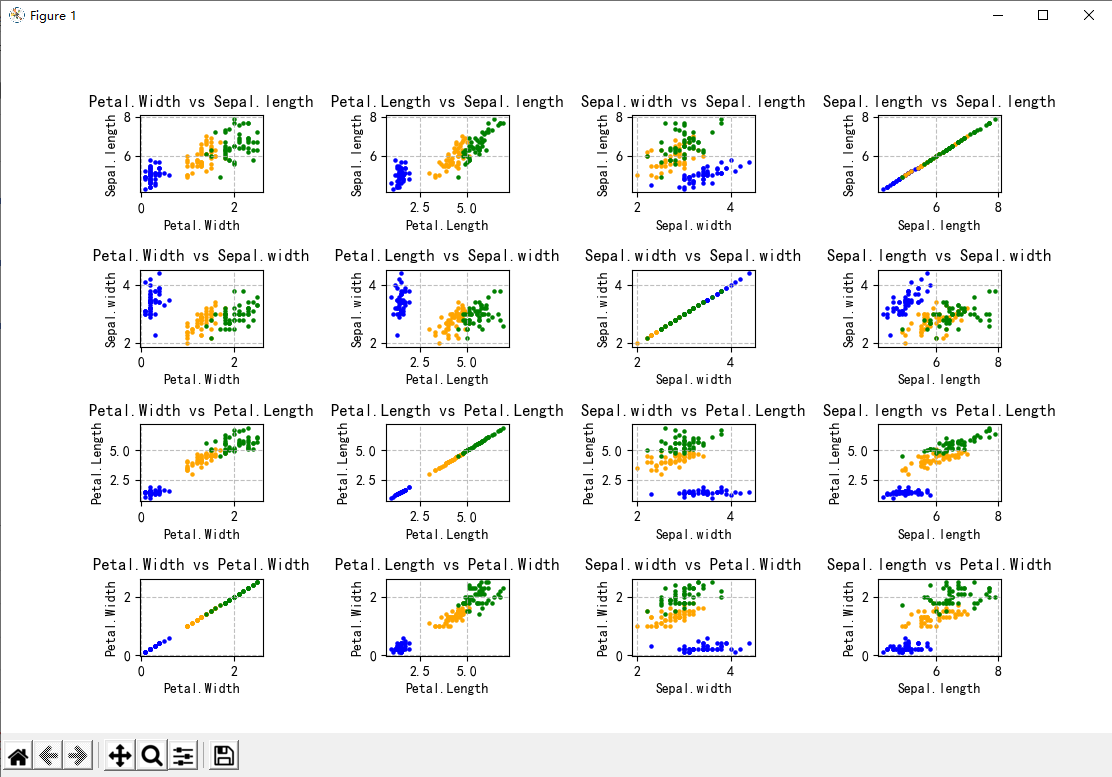
- 找一组自己感兴趣的真实数据,绘制出饼图。并看看数据的项数在什么范围比较合适在饼图中展示;
调整数据的顺序或角度,使得第一个扇区在 12 点方向开始;
调整字体的大小、标签的位置等参数。
选用了之前北京 2010-2015 年 PM 值状况所对应的的空气质量等级进行了饼图展示,调整了字体大小、位置、饼图大小、每一块的顺序(顺逆时针)、初始块的角度等。
```c++ from matplotlib import pyplot as plt import numpy as np import pandas as pd
from pylab import * mpl.rcParams['font.sans-serif'] = ['SimHei']
section = [0, 35, 75, 115, 150, 250, 99999] section_name = ["优", "良", "轻度污染", "中度污染", "重度污染", "严重污染"]
orig_df = pd.read_csv("./BeijingPM20100101_20151231.csv", encoding='utf-8', dtype=str) orig_df = pd.DataFrame(orig_df, columns=['year', 'month', 'day', 'PM_US Post']) df = orig_df.dropna(0, how='any')
df['PM_US Post'] = df['PM_US Post'].astype(np.int)
result = pd.DataFrame(pd.cut(df['PM_US Post'], section, labels=section_name, ordered=False)) result_count = result['PM_US Post'].value_counts(sort=False)
plt.pie(result_count, labels=result_count.index, startangle=90, counterclock=False, radius=1.5, textprops={'fontsize':8}, labeldistance=0.5) plt.show()
```
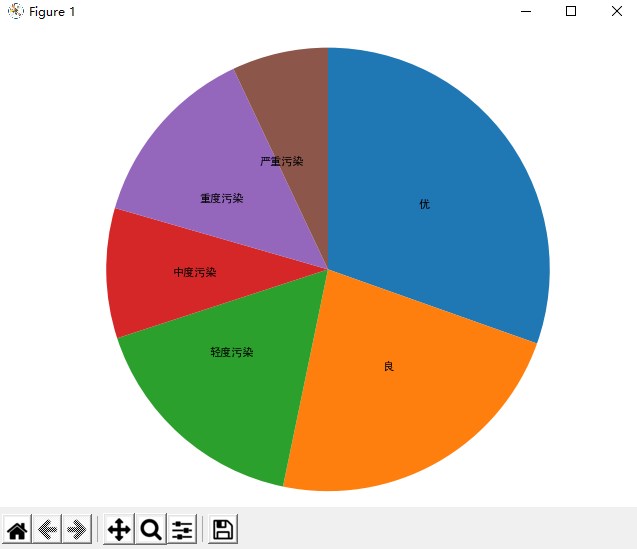
可以发现该饼图的严重污染部分已经发生了错位,因而饼图适合于 5~6 块,即最小块不要小于 15% 左右会比较好看。
- 在中国地图上展示每个省的高考人数或大学数量
选择展示各省/市的公办本科大学数量。
```c++ from pyecharts import options as opts from pyecharts.charts import Map import numpy as np import pandas as pd import random
df = pd.read_csv("./中国大学数量.csv", encoding='utf-8', dtype=np.str) df = pd.DataFrame(df, columns=['省/市', '公办本科大学数量']) df['省/市'] = df['省/市'].astype(np.str) df['公办本科大学数量'] = df['公办本科大学数量'].astype(np.int)
class Data: @staticmethod def province() -> list: res = [] for i in range(len(df)): res.append(str(df['省/市'][i])) return res
@staticmethod
def values() -> list:
res = []
for i in range(len(df)):
res.append(int(df['公办本科大学数量'][i]))
return res
def map2() -> Map: c = ( Map() .add("数量", [list(z) for z in zip(Data.province(), Data.values())], "china").set_global_opts( title_opts=opts.TitleOpts(title="各省公办本科大学数量"), visualmap_opts=opts.VisualMapOpts(min_=int(df['公办本科大学数量'].min()), max_=int(df['公办本科大学数量'].max()))) .set_series_opts(label_opts=opts.LabelOpts(is_show=True)) ) return c
map2().render("map2.html")
```
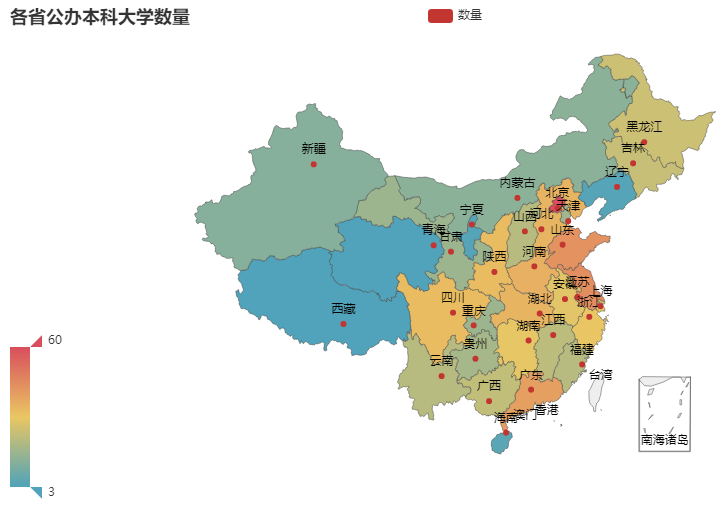
- 展示自己家乡所在城市的温度变化热力图,要求至少有 10 天的数据。
选取深圳市作图,爬取如下网址未来十天深圳市的天气数据
https://www.tianqi.com/shenzhen/15/](https://www.tianqi.com/shenzhen/15/)
```c++ import scrapy from weather.items import WeatherItem
class TianqiSpider(scrapy.Spider): name = 'tianqi' allowed_domains = ['tianqi.com'] start_urls = ['https://www.tianqi.com/shenzhen/15']
def parse(self, response):
item = WeatherItem()
data = response.xpath('//ul[@class="eed_a4ff_ff0ddc6 weaul"]/li')
for each in data:
item['date'] = each.xpath('a/div[1]/span[1]/text()').extract()
low = each.xpath('a/div[4]/span[1]/text()').extract()[0]
high = each.xpath('a/div[4]/span[2]/text()').extract()[0]
item['temperature'] = str((int(low) + int(high)) / 2)
yield item
pass
```
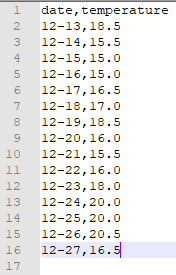
爬虫代码及结果如上
```c++ from pyecharts import options as opts from pyecharts.charts import Geo from pyecharts.globals import ChartType from pyecharts.render import make_snapshot from snapshot_phantomjs import snapshot import pandas as pd import numpy as np
df = pd.read_csv("./weather.csv", encoding='utf-8', dtype=np.str) df = pd.DataFrame(df, columns=['temperature']) df['temperature'] = df['temperature'].astype(np.float) day = 0
class Data: guangdong_city = ["深圳市"]
@staticmethod
def values() -> list:
res = []
for i in range(len(df)):
res.append(float(df['temperature'][i]))
return res
def geo_guangdong(title) -> Geo: c = ( Geo() .add_schema(maptype="广东") .add( title, [list(z) for z in zip(Data.guangdong_city, [Data.values()[day]])], type_=ChartType.HEATMAP, ) .set_global_opts( visualmap_opts=opts.VisualMapOpts(min_=0, max_=int(df['temperature'].max())),#is_piecewise=True), title_opts=opts.TitleOpts(title="广东省深圳市12月13-27日温度变化情况"), ) ) return c
for i in range(10): day = i str_date="12月" + str(i+13) + "日" make_snapshot(snapshot, geo_guangdong(str_date).render(), str(i+1)+".png", pixel_ratio=1)
```
生成 10 天热力图代码如上。

其中一张如上,其余另附。
- 生成一个直方图,有 25 根直方柱。要求直方柱的最小值是 1,最大值是 25,要求沿着边缘,从外到内逐步增大
```python import numpy as np import matplotlib.pyplot as plt import math from mpl_toolkits.mplot3d import Axes3D
1.生成fig对象和ax对象
fig = plt.figure() ax = fig.add_subplot(projection='3d') ax.set_xlabel('X Label') ax.set_ylabel('Y Label') ax.set_zlabel('Z Label')
2.生成数据
x = [] y = [] z = [i + 1 for i in range(25)]
left = up = -1 down = right = 5 px = py = 0 x.append(px) y.append(py)
def add(px, py): x.append(px) y.append(py)
while True: if px == 2 and py == 2: break while py + 1 < down: py = py + 1 add(px, py) left = left + 1 while px + 1 < right: px = px + 1 add(px, py) down = down - 1 while py - 1 > up: py = py - 1 add(px, py) right = right - 1 while px - 1 > left: px = px - 1 add(px, py) up = up + 1
bottom = [0 for _ in range(25)] width = depth = 0.5
3.调用bar3d,画3D直方图
ax.bar3d(x, y, bottom, width, depth, z, shade=True)
4.显示图形
plt.show() ```

- 生成一个金字塔的线图;
生成一上一下两个金字塔,叠放在一起。
```c++ import numpy as np import matplotlib.pyplot as plt import math from mpl_toolkits.mplot3d import Axes3D
1.生成fig对象和ax对象
fig = plt.figure() ax = fig.add_subplot(projection='3d') ax.set_xlabel('X Label') ax.set_ylabel('Y Label') ax.set_zlabel('Z Label')
2.生成数据
x = np.array([1,0,2,1,2,2,1,2,0,1,0,0]) y = np.array([1,0,0,1,0,2,1,2,2,1,2,0]) z = np.array([1,0,0,1,0,0,1,0,0,1,0,0]) z_minus = -1 * z;
3.调用plot,画3D的线图
ax.plot(x,y,z_minus,"b",marker='o') ax.plot(x,y,z,"r",marker='o')
4.显示图形
plt.show() ```
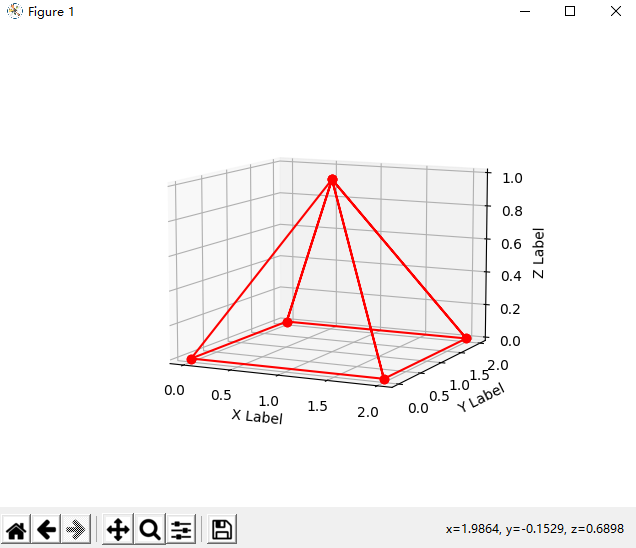
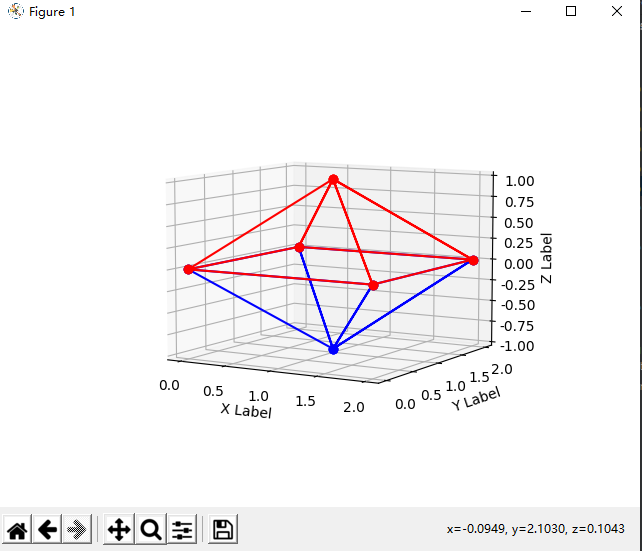
- 生成一个散点图,z=x^2+y^2
```python import numpy as np import matplotlib.pyplot as plt import random import math from mpl_toolkits.mplot3d import Axes3D
1.生成fig对象和ax对象
fig = plt.figure() ax = fig.add_subplot(projection='3d') ax.set_xlabel('X Label') ax.set_ylabel('Y Label') ax.set_zlabel('Z Label')
2.生成数据
x = np.linspace(-100,100,10000) np.random.shuffle(x) y = np.linspace(-100,100,10000) np.random.shuffle(y) z = x 2 + y 2 - 20000 z_minus = -1 * z ax.scatter(x, y, z, zdir='z', s=1, c='r', marker='.', depthshade=True) ax.scatter(x, y, z_minus, zdir='z', s=1, c='b', marker='.', depthshade=True)
4.显示图形
plt.show()
```
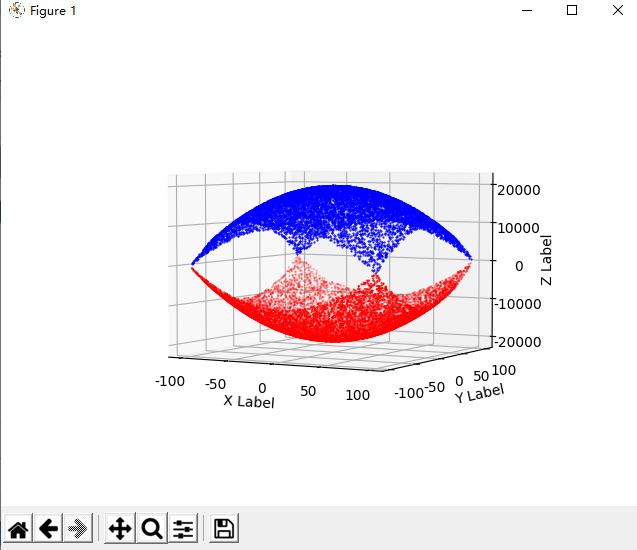
4. 心得与体会
在本次实验中,通过几道题目的引导,逐步掌握了 python 中使用 matplotlib 绘制二维散点图、饼图,绘制三维的直方图、线图、散点图等,以及利用 pyecharts 在地图上绘制各种图标。非常感谢老师的实验设计!
参考文献
- 建筑设计院图档管理系统的设计与实现(吉林大学·时淮龙)
- 基于JSF的Web GIS设计与实现(昆明理工大学·刘波)
- 基于FC-SAN的图形文件存储管理系统(电子科技大学·杨易)
- 数字图像与矢量数据在空间数据库中的存取分析与应用(山东科技大学·姜永阐)
- 建筑设计院图档管理系统的设计与实现(吉林大学·时淮龙)
- 基于VML的计算机图形学在线学习系统(贵州师范大学·骆帝勇)
- 基于WebGIS的快速解译制图系统的研究与实现(中国地质大学(北京)·周文豪)
- 基于深度学习的图像美学推荐方法研究(北京工业大学·冯文颖)
- 基于FC-SAN的图形文件存储管理系统(电子科技大学·杨易)
- 基于移动平台的图片制作系统设计与实现(上海交通大学·项亮)
- 基于知识图谱的中职Python教学案例设计与应用(山东师范大学·宫兆坤)
- 网络流量统计分析系统(吉林大学·石景龙)
- Linux环境下基于Web的图档管理系统的开发(山东科技大学·刘治国)
- 基于知识图谱的中职Python教学案例设计与应用(山东师范大学·宫兆坤)
- 基于J2EE的遥感影像数据库检索与发布系统的设计与实现(首都师范大学·陈於立)
本文内容包括但不限于文字、数据、图表及超链接等)均来源于该信息及资料的相关主题。发布者:代码货栈 ,原文地址:https://m.bishedaima.com/yuanma/36159.html











